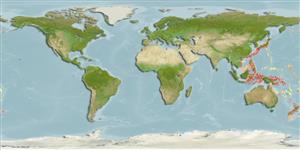Common names from other countries
Environment: milieu / climate zone / depth range / distribution range
Ecología
marino batidemersal; rango de profundidad 250 - 300 m (Ref. 28016). Deep-water
Western Pacific: southern Japan to the South China Sea except Ryukyu Islands.
Tamaño / Peso / Age
Maturity: Lm ? range ? - ? cm
Max length : 18.0 cm TL macho / no sexado; (Ref. 2272)
Short description
Claves de identificación | Morfología | Morfometría
Espinas dorsales (total) : 4 - 6; Radios blandos dorsales (total) : 13 - 15; Radios blandos anales: 13 - 15; Vértebra: 26. Lower edge of preopercle with 3 spines, very rarely to be more. Labial fimbriae simple and poorly developed. Posterior nostril slitlike. Dorsoposterior margin of pectoral fin slightly concave; pectoral and caudal fins pale yellow in fresh specimens. Fifth proximal anal pterygiophore (the first to follow a complete haemal spine) usually inserts between the haemal spines of 13th and 14th vertebrae (Ref. 11439).
Found near shore, down to 260 m, on sand and sandy mud bottoms (Ref. 11230). Spend a large part of their time buried in the mud or sand with only their eyes and a portion of the mouth protruding (Ref. 4716). Cleithral spine with venom gland (Ref. 57406).
Life cycle and mating behavior
Maturities | Reproducción | Spawnings | Egg(s) | Fecundities | Larva
Masuda, H., K. Amaoka, C. Araga, T. Uyeno and T. Yoshino, 1984. The fishes of the Japanese Archipelago. Vol. 1. Tokai University Press, Tokyo, Japan. 437 p. (text). (Ref. 559)
IUCN Red List Status (Ref. 130435)
CITES (Ref. 128078)
Not Evaluated
Human uses
Pesquerías: comercial; Acuario: Comercial
Herramientas
Special reports
Download XML
Fuentes de Internet
Estimates based on models
Preferred temperature (Ref.
115969): 1.8 - 14.9, mean 12.4 (based on 26 cells).
Phylogenetic diversity index (Ref.
82804): PD
50 = 0.5000 [Uniqueness, from 0.5 = low to 2.0 = high].
Bayesian length-weight: a=0.00776 (0.00315 - 0.01914), b=3.09 (2.90 - 3.28), in cm Total Length, based on LWR estimates for this Genus-body shape (Ref.
93245).
Nivel trófico (Ref.
69278): 3.9 ±0.7 se; based on size and trophs of closest relatives
Resiliencia (Ref.
120179): Medio, población duplicada en un tiempo mínimo de 1.4-4.4 años (Assuming tmax>3).
Fishing Vulnerability (Ref.
59153): Low vulnerability (10 of 100).
